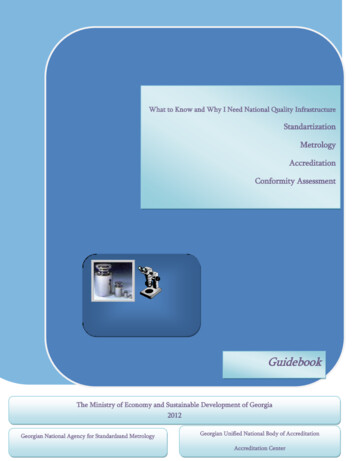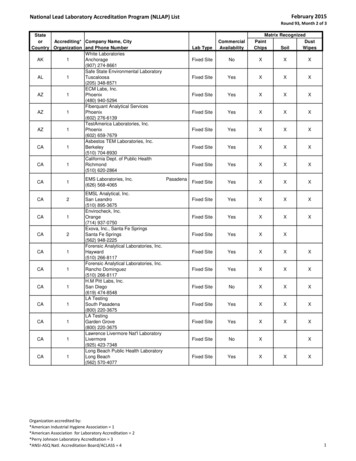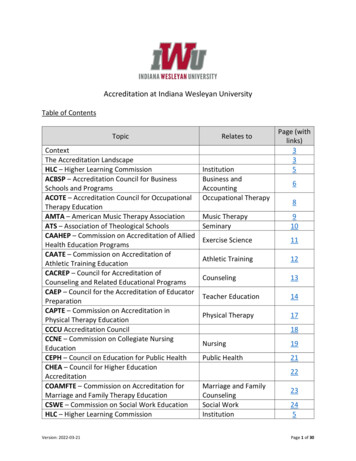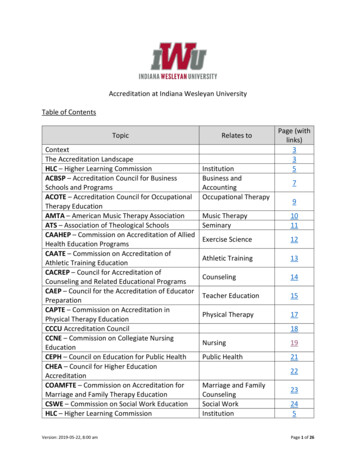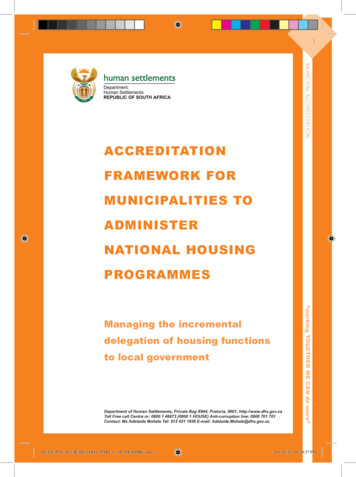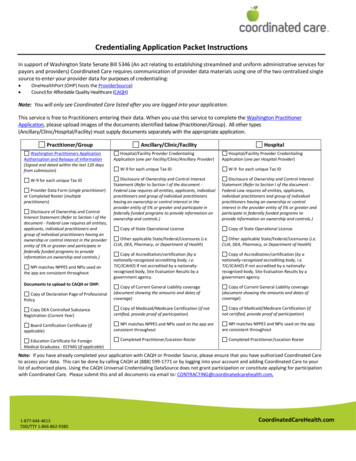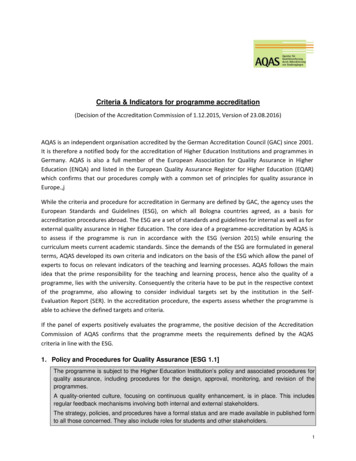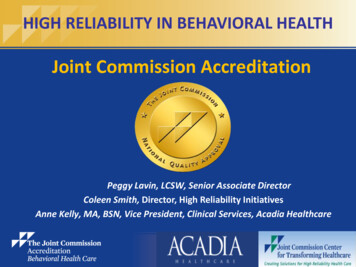
Transcription
HIGH RELIABILITY IN BEHAVIORAL HEALTHJoint Commission AccreditationPeggy Lavin, LCSW, Senior Associate DirectorColeen Smith, Director, High Reliability InitiativesAnne Kelly, MA, BSN, Vice President, Clinical Services, Acadia Healthcare2017 Copyright, The Joint Commission
High Reliability:A Behavioral Health JourneyAnne Kelly, MA, BSNAcadia HealthcareVice President, Clinical Services14
Presentation Topics Initiation of a behavioral health high reliability journey. Benefits of high reliability for culture of safety. Clinical and leadership tools inspired by high reliabilityand culture of safety. Lessons learned and next steps.15
Acadia Healthcare Established in January, 2005. Headquartered in Franklin, Tennessee. Acadia operates a network of 576 behavioralhealthcare facilities with approximately 17,300 bedsin 39 states, the United Kingdom and Puerto Rico. Provides behavioral health and addiction services ina variety of settings, including inpatient psychiatrichospitals, residential treatment centers, outpatientclinics and therapeutic school-based programs.16
Embarking on a High Reliability Journey From triennial survey to high reliability operationalplan – learning from literature and surveyors. 2016, year one – taking our first steps andoperationalizing high reliability characteristics. 2017, year two – dedication to Preoccupation withFailure. Engaging leadership and clinical teams. Integrating high reliability with a culture of safety.17
Defining a Robust Culture of Safetywith Human FactorsStarting with the end in mind There is a Zone of Safety – that encompasses the facility campus –composed of commitment, trust, and partnership. Staff are attentive – checking, situationally aware,proactively/urgently acting – Everyone is responsible for safety. Patients are engaged as participating partners in their own safety. Processes are standardized, on time, “run like clock-work.” Clinical data is analyzed and relied upon to evaluate safety andadvance with high reliability – as a learning organization. Everyone, including visitors, play a vital, defined role in maintaininga safe environment.18
Acadia Culture of Safety Engaging and empowering everyone in the role of safety. Learning from our incidents, close calls, and experiences. Instilling and reinforcing safety thinking and doing – becomingwhat we think about – safety, first and foremost Sharing and communicating so that everyone is engaged. Starting where we are, using what we have, doing what wecan.Our best defense and strategy is to become safety.Safety is not a project, but a way of thinking and doing.19
Preoccupation with FailureFAA: Human Factors - To Mitigate the Risk of Complacency Always expect to find something wrong. Never sign off on something that you did not fullycheck. Always double check your work.20
Prevention Through Detection and Sustainment Actions(preoccupation with failure)Proactive StrategyDetectionPurposeHow to Sustain – for SafetySafety Huddles-Patient issues-Changes in condition-Share critical information.-Inspires trust and respect.Standardize format and schedule.Leadership Rounds-Problems when they are small andeasily fixed.-Good work to promote-Routines/system issues-Provides important opportunities for on-the-spot actions andcoaching.-Allows for detecting issues before problems develop.-Inspires trust and respect.-Standardized format and routine.-Update format and staff rotation. periodically – takingadvantage of “fresh eyes.”-Always expect to find something wrong.Time out – for High Risk Processes-Breaks in systems and policies thatcan lead to harm.-Double checks work/process.-Reinforces signing off on the work that is checked.-Standardize format and process.-Support staff who call “time out.”Safety NetsVulnerable/high risk issues that canlead to harm.-Provides special measures for high risk processes.-Fosters communication among team.-Inspires trust and respect.-Implement procedure with team support.-Include in facility routines and committees.-Report to Leadership and Board.Safe Catches-Close calls-Possible process issues-Develops and instills trust: reporting incidents is greatly valuedand utilized for safety.-Foster and celebrate staff reporting.-Publicize safe catches.-Use safe catches to strengthen processes.Acadia Staff I CAN – safety campaign-Breaks in systems and policies thatcan lead to harm.-Issues that can be easily corrected.-Empowers and engages all Acadia staff in safety thinking andacting.-Provides a safety measure that can be incorporated into anysafety program.-Place posters in key staff areas.-Share in new employee orientation.-Include in safety training and education.Patient Community Group –I CAN Stay Safe-Concerns and issues-Misinformation-Engages and empowers patients in safety.-Shares information proactively.-Establish weekly meetings (at a minimum) withstandardized information.-Post I CAN (for patients) information in visible areas.Engaging Visitors in Safety –I CAN Partner with Safety-Concerns and issues-Misinformation-Engages and empowers visitors in their role with safety.-Share information proactively.-Post I CAN (for visitors) information in visible areas.-Provide brochure to visitors.Targeted Solutions Tools (TST)-Systems and procedural issues thatcan cause patient harm.-Provides a methodical way of gathering and analyzing data fortargeted clinical solution.-Use one of three TST tools: Preventing Falls, HandHygiene, and Hand-off Communications.21
Key Elements of Safety Huddles22
Safety Huddles Form23
Key Elements of Leadership Rounds Standardized format – revised periodically. Schedule of rounders – good mix of clinical and nonclinical staff (administrative, direct care staff,support staff). Information from rounds is shared with staff and incommittees - with actions taken. Sample questions:“Have there been any near misses that almost caused patient harm but didn’t?”Examples: Selecting a drug dose from the medications cart or pharmacy to administer to apatient and then realizing it’s incorrect.Incorrect orders by physicians or others caught by nurses or other staff.“Have there been any incidents lately that you can think of where a patient was harmed?Examples: InfectionsClose call - suicide attemptClose call – elopement24
Key Elements of a Time out – for High Risk ProcessesA checklist method of assessing for any concerns that may lead to achange, or stop, to a high risk process.Recommended for: discharge process and suicide risk assessments. Reinforces a standardized process with multidisciplinary responsibilities. Utilizes a checklist process to ensure all required documentation. Empowers staff to stop the process before the patient is actuallydischarged. Creates a Safe Space for staff to speak up and intervene. Allows for metrics that can be used to evaluate the high risk process.25
Key Elements of a Safety NetAn identification process of patients with high risk issues that need special monitoring and follow-up.Recommended for: medically complex patient population and high risk processes undergoing revision/improvement.For Medically Complex Patients: Daily identification and check-listing of patients with medically complexities – starts in Intake/Admissions department. Checklist is reviewed by nursing, medical staff, Intake staff, and leadership – for multidisciplinary involvement and accountability. Safety Net Patients are reviewed daily – to ensure follow-up of issues, special procedures and labs, and treatment planningBenefits include: Early identification of high-risk issues so that proactive actions can be taken. Rapid response to high-risk patient characteristics and problem-prone processes. Frequent, real-time monitoring and re-evaluation. Safe Space develops – to speak up and share ideas – no shame or retaliation Measurable outcomes/data can be used to improve care in alSignsLab –ResultSpecialProceduresAccu 26
Acadia I CAN CampaignAcronym for staff engagement and empowerment Check consistently q15 min, LOS, 1:1 Act urgently intervene to keep the patient safe Notify immediately charge nurse, doctor, supervisor27
Patient Engagement in Safe Health Care28
Patient Engagement in Safe Health CareDeveloped by: Tracey Jensen, MA29
Visitor Engagement in Safety Place I CAN (for visitors) poster in lobby area. Provide handout or brochure on key safety elements. Clearly define the visitor responsibilities withaccountability. Share clinical information, as appropriate, with visitorsand family members so they are engaged as a partner insafety.30
Visitor GuidelinesDeveloped by: Tracey Jensen, MA31
Acadia Healthcare Goals for SafetyIt comes down to one word – one number – zero incidentsof harm. Using High Reliability thinking as a different way forward. Moving forward, incrementally, in a prioritized way. Using best practices and initiatives in a standardized way. Remaining vigilant of our risks and mitigating proactively. Engaging everyone in our culture of safety (leaders, staff,patients, visitors).32
Looking back to look forward Journey lessons: Engaging others when planning and learning begins. Involving board members into the process. Encouraging direct staff involvement in tooldevelopment. Next steps: 2018: Sensitivity to Operations – the Year of the Metric. Increase use of ORO 2.0 and related tools. Promote Culture of Safety through all levels of care.33
ReferencesAgency for Healthcare Research and Quality (n.d.). AHRQ's patient safety initiative: Building foundations, reducing risk.Retrieved from https:// scongrpt/psini2.html.Agency for Healthcare Research and Quality (n.d.). Chapter 5: Building Trust. Retrieved from https:// e5.html.Federal Aviation Administration (2012) Avoid the dirty dozen. Retrieved from https: //www.faasafety.gov/files/gslac/library/ l Aviation Administration (n.d.). Human factors. Retrieved from https: //www.faa.gov/regulations policies/handbooks manuals/aircraft/media/AMT Handbook Addendum Human Factors.pdf.Occupational Health and Safety (2010, September 1). Complacency – The Silent Killer. Retrieved from https://ohsonline.com aspx?Page 2.The Joint Commission (2017). Webinar Replay and Slides: Building Your Safety Culture: A Job for Leaders. Retrieved fromhttps: //www.jointcommission.org/webinar replay slides sea issue 57 building your safety culture leaders/.34
Questions2835
The Joint CommissionThe Joint Commission’s Gold Seal of ApprovalTMmeans your organization has reached for and achievedthe highest level of performance recognition availablein the behavioral health field.36 Copyright, The Joint Commission
Assistance and Resources2017 Complimentary WebinarsTMJan 24SAFERFeb 14Accreditation BasicsMar 14Roadmap to Accreditation: The Steps to SuccessApril 11WEBINARS HELD:May 910-11 AM PACIFIC11-12 PM MOUNTAINJun 1312-1 PM CENTRAL1-2 PM EASTERNJul 11Matrix: New Changes to Survey ScoringMeasurement-Based Care: How, Why and When to be ReadyOrientation to the Accreditation RequirementsStrategies for a Successful SurveyConquering Challenging StandardsAug 15Conduct Your Own Mock SurveySept 12Medication-Assisted Treatment in Substance Use DisordersOct 10High Reliability in Behavioral Health CareNov 7Resources for ReadinessNote: Register for webinars or view previously conducted webinars at www.jointcommission.org/BHCS37
Assistance and ResourcesBHC Annual ConferenceOctober 12-13, 2017, Rosemont, e-conference-october-12-13-2017/?ref TJCAL173038
Behavioral Health Care AccreditationBusiness Development TeamEXECUTIVE DIRECTORJulia Finken, RN, BSN, MBA, CPHQJfinken@jointcommission.org630/792-5790WEST REGIONMegan Marx-Varela, MPAAssociate 1EAST REGIONPeggy Lavin, LCSWSenior Associate sa Butler, MBABusiness Development arrell AndersonSenior Business Development 6MARKETINGMelinda Lehman, MBAAssociate Directormlehman@jointcommission.org630/792-569539
Behavioral Health Care AccreditationOperations TeamAllison KikilasOperations er Vance, LPCC, CPHQField in Wessels, LCSWAssociate Director, onform.aspx630/792-5900(If your question concerns the Life Safety Chapter, please call 630/792-5900 and ask for a JointCommission engineer or email engineer@jointcommission.org)40
See you on the accreditation road!4241
Julia Finken, RN, BSN, MBA, CPHQ Jfinken@jointcommission.org 630/792-5790 EAST REGION Peggy Lavin, LCSW Senior Associate Director plavin@jointcommission.org 630/792-5411 . Melinda Lehman, MBA Associate Director mlehman@jointcommission.org 630/792-5695 39. Behavioral Health Care Accreditation Operations Team Allison Kikilas
